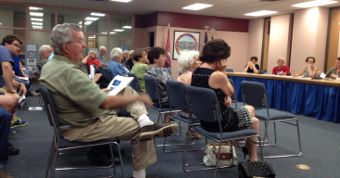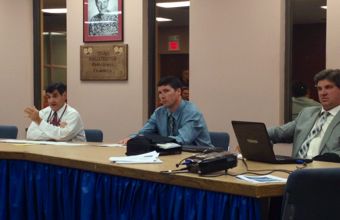 Derby residents are being asked to cough up an extra $257 a year for the next 30 years to pay for major repairs to the city’s long-neglected sewer system.
Derby residents are being asked to cough up an extra $257 a year for the next 30 years to pay for major repairs to the city’s long-neglected sewer system.
And that’s only for a typical single-family property. A typical two-family property could see a sewer bill increase by $514.
Larger non-residential users, such as Griffin Hospital, could see a $95,000 increase.
The money will be used to fund $30.7 million in repairs to the city’s sewer system.
The Derby Water Pollution Control Authority, a volunteer board, held a public hearing on the proposed referendum Wednesday.
The Board of Aldermen and the city’s Board of Apportionment and Taxation were scheduled to meet Thursday to talk about officially putting the sewer referendum on the November ballot.
About 40 people attended Wednesday’s WPCA public hearing, and about 10 people spoke — and most were not happy.
As it stands, the cost for the referendum will be put on sewer users only, not people who use septic tanks.
 Resident Theodore Anglace didn’t believe any of the data engineers presented, including the amount of sewage flowing into the city’s treatment plant every day.
Resident Theodore Anglace didn’t believe any of the data engineers presented, including the amount of sewage flowing into the city’s treatment plant every day.
Resident Elsie Bartomioli, 83, said she could not afford such a steep increase in her sewer bill.
She asked a question many were wondering — how did the city’s sewer system get to the point where it needed $30.7 million repairs, all done at once?
“Where has everybody been all these years?” she asked.
Resident Dee Kopchik wanted answers, too.
“Why wasn’t there oversight to make upgrades over the last 30 years to this system?” she asked.
The video below shows a conversation between Kopchik and WPCA Chairman John Saccu. Story continues after the video.
Neither members of the WPCA nor their engineers were willing to assign direct blame, but they said the city has taken a Band-Aid approach to its sewer system for decades.
A $4 million referendum in 2000 barely made a dent in the infrastructure issues within the system, they said.
The WPCA workers do constant maintenance on the system — but they’re making repairs to pump stations built in the late 1960s. Three pump stations must be replaced, officials said.
Daniel Lawrence, a project manager with Weston & Sampson, the Derby WPCA’s engineering firm, told the audience that the WPCA, its workers and his firm have been working to finally get the authority on the right track.
They’ve worked on a facilities study, a plan that outlines and organizes long-term repairs; they’ve been studying how much stormwater infiltrates the sanitary sewers; and they’ve been talking to Ansonia about possibly connecting Derby to Ansonia’s sewer system, at some point — but officials stress the repairs are still needed even if the city decides to connect to Ansonia.
Click play on the video below to hear Lawrence respond. Story continues below.
Resident Adam Pacheco wanted assurances Derby voters weren’t pouring $30.7 million down the drain.
He pressed members of the WPCA to explain what they’re doing to prevent the city from turning a blind eye to its sewer infrastructure for another 30 years.
Saccu, a volunteer, said the WPCA is working with accountants to build a reserve fund that will be put toward long-term repair and maintenance.
The engineers, and Derby City Treasurer Keith McLiverty, tried to explain that paying for the repairs over 30 years, while obviously painful to sewer users, is a safer bet than not doing anything, or just targeting one or two of the seven repair projects.
The pump stations and equipment at the main sewage treatment plant are in “various stages of failure,” Saccu said.
Basically, the WPCA and the engineers said Derby sewer users will pay for the repairs one way or the other no matter what — and voting yes for the referendum is the lesser of two evils.
They argued that while the referendum will cost the typical family an extra $257 per year, a catastrophic failure of a single, big-ticket item, such as the Roosevelt Avenue pump station, could cost sewer users $365 per year in an emergency repair situation.
Failures of two pump stations could tack on $445 to the sewer bill at a single-family property.
McLiverty’s offered a concise summary of the situation sewer users face:
“It stinks.”
“You’re right. We failed. The city has not maintained this,” McLiverty told the audience.
But, in terms of financial prudence, McLiverty said it makes more sense to borrow money at a low interest rate now and spread the payments out over time, which will stabilize bills and prevent massive, single-year spikes in rates from emergency repairs.
It’s a better way to clean up the mess, the treasurer indicated.
“We can say no, but if you say no, you’re saying no to how to fund it,” McLiverty said. “They are going to tax us one way or another on this. That’s the reality.”
Click here to listen to a portion of McLiverty’s statement:
Lawrence and Anthony DeSimone, another engineer from Weston & Sampson, walked the public through the repair plan for an hour Wednesday.
They used the embedded document below. Story continues after the document.
Derby WPCA – Referendum Public Hearing Presentation – Sept 3 2014
The projects include:
$830,000 to build a new South Division Street pump station
- The current pump station was built in1966 and has never been upgraded
- The steel walls are rotting away
$1,070,000 to build a new Burtville Avenue pump station
- The current pump station was built in 1965 and was never upgraded
- The pump station is 20 feet underground, and is a safety concern for workers because there is no “fall protection”
- It floods
$7,460,000 for a new Roosevelt Drive pump station
- Pumps 40 to 50 percent of all sewage flow in Derby, yet hasn’t had a significant upgrade since 1972
- Built in 1966
- In recent years, was cited by state environmental regulators for allowing raw sewage to flow into the Housatonic River. The WPCA, under threat of fines, put in a new “grinder.”
- Steel body is rotting away
$3,780,000 for a new Roosevelt Drive forcemain
- Will increase capacity from 2,000 gallons a minute to 4,000 gallons a minute by replacing a 12-inch pipe with a 16-inch pipe
- City officials see this as a way to encourage the Town of Seymour, along Route 34, to connect to Derby system, which would provide revenue
- WPCA engineers also said it is needed to help with possible redevelopment projects along Route 34 heading west of downtown (example — the former Derby Cellular property)
- Engineers said it doesn’t make sense to upgrade the Roosevelt Drive pump station and leave an undersized forcemain in the ground
$3,660,000 to replace downtown/Route 34 sewers
- Current downtown sewers are too small and limit economic development
- Project will be coordinated with long-planned state Department of Transportation Route 34 widening, which makes this project a bit cheaper
$8.9 million for various upgrades at the Derby Water Pollution Control Facility (sewage treatment plant, the heart of the system)
- Install modern “grit removal system:” current “grit removal system” is often a guy in waders with a long stick
- Install modern electrical system, eliminating safety issues
- Replace 1966 anaerobic digestion system
$5 million for upgrades to “solids handling system” at the sewage treatment plant
- Current system is a mess, requires constant repairs and causing large overtime costs
- Belt filter press was installed in 1980, failed and had to be repaired in 2010, 2011, 2012, 2013 and 2014.
- Rotary thickener is from 1972
- Constant failures as well
- Some parts of the solids handling system are kept together with duct tape and rusted vice grips